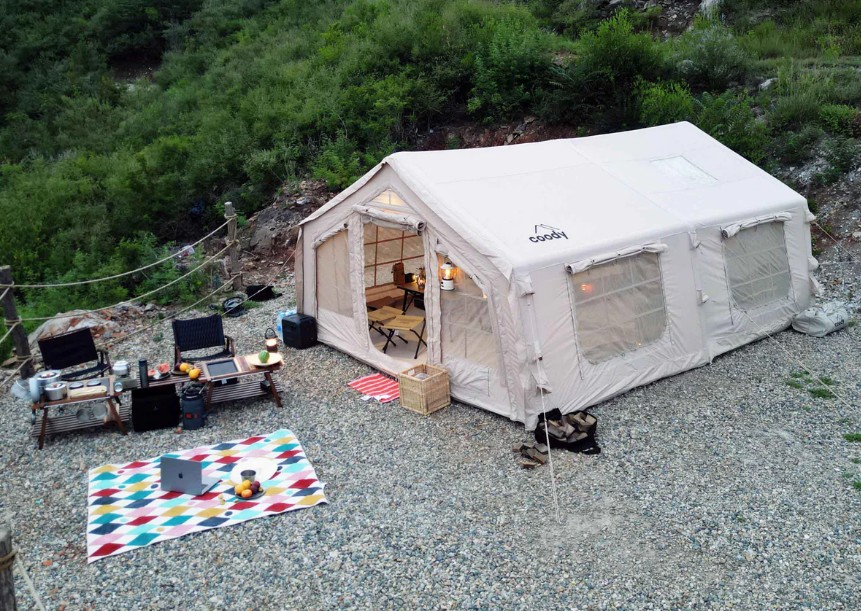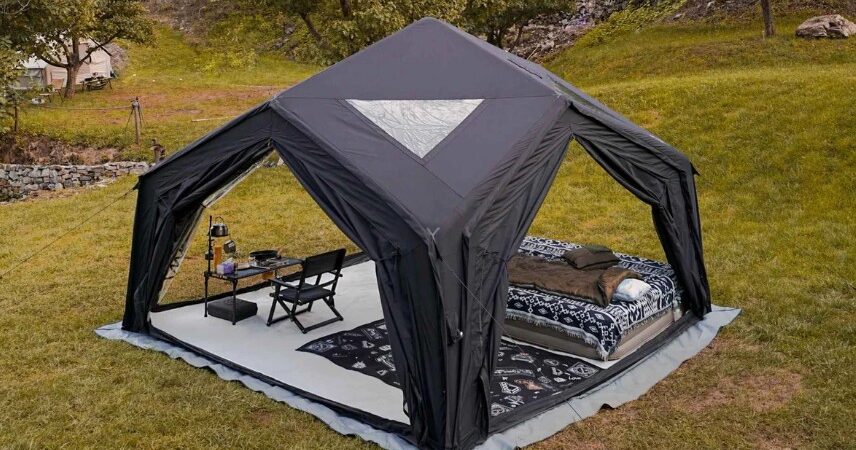What is a premium inflatable camping tent?
A premium inflatable tent replaces traditional metal poles with air beams. Instead of assembling rods and tensioning lines, you simply inflate it — and it stands. It’s designed for campers who value both comfort and ease, without compromising on durability or weather protection.
Unlike low-end festival-style tents, premium inflatable models like Coody use marine-grade materials, breathable canvas, and smart structural engineering. These are real shelters — built to last, not to leak.
How do inflatable tents differ from traditional tents?
The key difference is the frame.
- Traditional tents use aluminum or fiberglass poles. They’re rigid, heavy, and take time (and often two people) to assemble.
- Inflatable tents use air beams made of reinforced PVC. You inflate the structure using a manual or electric pump, and it holds its shape securely under pressure.
Setup takes minutes, not hours — even for large models. And you can do it solo.
What materials are used in premium inflatable tents?
Quality varies widely. Coody, for example, uses:
- TC canvas (35% cotton / 65% polyester): Breathable and water-resistant.
- Boat-grade PVC air beams: Durable, fire-retardant, and pressure-tested.
- Detachable TPU windows: Provide insulation and clarity, even in cold.
- 300D polyester floors with raised edges: Keep out water and insects.
These aren’t novelty materials. They’re selected for real-world performance, tested down to -40°C.

Why choose an inflatable tent for your outdoor adventures?
Because they’re more than tents — they’re portable cabins.
Premium inflatable tents give you:
- Rapid setup (even for large families)
- Full-standing height and open space
- Better airflow and insulation (especially with cotton-blend canvas)
- All-season reliability
- Safe indoor stove use in winter-ready models
You don’t have to rough it to enjoy the outdoors. These tents create a new category: comfort without compromise.
How does portability compare?
Surprisingly well.
While Coody’s larger models can weigh up to 60kg (132 lbs) with accessories, they pack into manageable bags that fit in SUVs and trailers. Mid-size models like Coody 8.0 are around 28kg (62 lbs), ideal for solo or duo campers.
Are inflatable tents durable?
Yes — if you choose the right one.
Premium tents are tested for:
- Wind tunnel resistance
- Cold cracks (down to -40°C)
- Mold, UV, and fire resistance
- High-pressure inflation
They’re not just durable — they’re engineered for year-round use.
How to set up a premium inflatable tent?
Step-by-step:
- Unroll the tent and lay it flat.
- Attach the pump to the main valve.
- Inflate each beam until fully firm (usually 5–7 PSI).
- Stake down corners and guy lines.
- Zip in floor if detachable.
Manual setup takes about 5–10 minutes for mid-size tents, 15 for larger ones. With an electric pump like Coody’s CG-100, even less.
Tools Needed:
- Manual or smart electric pump
- Stakes and guy ropes (usually included)
Common Mistakes to Avoid:
- Overinflating (premium tents come with pressure relief valves to prevent this)
- Skipping guy lines in windy conditions
- Not securing floor zippers (can let water in)
How to choose the right inflatable tent
1. Size
Choose based on people + gear:
2–3 people → Coody 8.0 or 10.0
4–6 people → Coody 13.6
6+ or multi-room → Coody 17.2 Familia
2. Weather resistance
For year-round camping, choose TC canvas and fire-retardant flooring. TPU windows and insulated walls are a must for cold climates.
3. Ventilation & Storage
Look for:
- Multiple mesh windows
- Ceiling vents or skylights
- Detachable floors (for flexible configurations)
- Covered vestibules for gear
How to maintain your inflatable tent
Cleaning
- Use mild soap and water (no bleach)
- Dry completely before storage
- Remove detachable floors for separate cleaning
Damage prevention
Avoid dragging on sharp terrain
Store off the ground with a footprint or tarp
Use pressure valves to avoid overinflation
Storage tips
Always store dry
Keep in breathable storage bags
Check valves and zippers before next use
Where can you use these tents?
They’re made for more than national parks:
- Family camping trips
- Glamping retreats
- Fishing and hunting expeditions
- Backyard guest lodges
- Music festivals or overland basecamps
If you can drive there, you can camp there.
What are the best brands and models?
While there are several notable names in the inflatable tent space, Coody stands out due to:
- Expert Korean design
- Fire-tested, child-safe materials
- Sturdy zippers, marine-grade beams
- Real-life feedback from global customers
From compact solo tents to modular shelters that dock together, Coody’s range is comprehensive — and highly rated.
Final thoughts: Is a premium inflatable tent right for you?
Ask yourself:
- Do you want to spend more time relaxing, not assembling?
- Do you need something that works in all seasons?
- Are you looking for a mobile, breathable home from home?
If yes, a premium inflatable tent is worth the investment.
There are cheaper tents, sure. But there’s no substitute for the security, comfort, and space these shelters provide. They’re not for one weekend — they’re for a lifestyle.
Want to explore models and setups?
Check out Coody’s full tent range or speak to their team for a personalized recommendation.
FAQ
What is an inflatable tent?
A tent with air beams instead of poles. Just pump it up — no complex setup.
How is it different from traditional tents?
Inflatable tents are faster to set up, more stable in wind, and more comfortable inside.
Are they durable?
Yes. Premium models use canvas, PVC, and are tested for all weather conditions.
Good for families?
Absolutely. Many models offer large spaces, extra room, and stove-ready insulation.
Can I use it year-round?
Yes. Designed for all seasons, with breathable fabric and heat-retaining windows.
How long does setup take?
5–15 minutes with a manual or electric pump.
Where can I buy one?
Check out RBM Outdoors to discover high-quality, reliable air tents.







